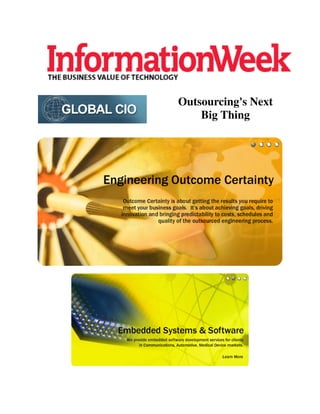
Symphony In Information Week
- 1. Outsourcing's Next Big Thing
- 2. Down To Business: Outsourcing's Next Big Thing 'Outcome-based' contracts are all the rage, but there's often a big gap between what CIOs say they want and what they're ready to do. By Rob Preston InformationWeek August 29, 2009 Outsourcing providers are touting their ability to move beyond service-level agreements to deliver services tied to customers' business results--higher sales, lower costs, reduced errors. CIOs say they're wide open to forging such deeper, "outcome-based" partnerships, where their vendors share in the risks and rewards of major IT implementations and upgrades. But if outcome-based outsourcing is ever to work as advertised, customers will have to put more skin in the game as well. The IT outsourcing (especially offshoring) movement has been mostly about what Forrester analyst Bill Martorelli calls "staff augmentation"--contracting for the cheapest people to hack code, monitor data centers, man help desks, and do other basic but essential IT work. Customers have grown accustomed to managing outsourcing resources, not business outcomes, he notes. But most companies are reaching the point where they can't squeeze any more savings from body shops. And with IT budgets still under intense pressure, they're exploring alternative outsourcing models to find new efficiency gains. In a survey conducted by InformationWeek early last year, 20% of 430 IT pros working with Indian outsourcers cited the "ability to tie project costs to business goals" as a key benefit that would prompt them to work with an outsourcer again. Providers are starting to step up. The enterprise group of India's Infosys says more than half of its deals carry some element of outcome-based pricing. Wipro, Tata, Accenture, IBM, and other providers are all scrambling to move up the stack to higher-margin services as industry growth slows. Two-thirds of the nearly $200 million revenue of Symphony Services, a fast-growing provider of outsourced software development services, has an outcome basis, says CEO Gordon Brooks. For example, under a contract to provide BMC Software with product development, quality assurance, and customer support services for select BMC products, Symphony will share in the revenue its services help generate, a share that's "drastically reduced" if it doesn't deliver on time. Outcome-based outsourcing isn't more widespread, Brooks says, because most vendors and customers aren't prepared to manage them. All outcomes, whether judged on business results, product quality, or timeliness, must be quantifiable. "You must be a completely metrics-oriented business to make this work," he says. It took Symphony two years to set up the processes to define and track those metrics, a methodology it now offers to partners as a service. "Clients aren't pulling us into this," Brooks insists. "We're pulling them into it." Forrester's Martorelli says customers are pulling as well, though he agrees with Brooks that there's often a big gap between what CIOs say they want and what they're ready to do. Among the challenges he sees, besides the sheer complexity of defining and measuring business outcomes: Outsourcing managers fear losing status and control if they're no longer managing people and projects; and support from top management may be lacking, especially if the benefits of structuring outsourcing contracts around outcomes aren't obvious. But as my colleague Bob Evans notes in his column on JetBlue's successful "all you can fly" program, customers in every industry will increasingly reward suppliers that give them more choices and allow them to "co-create value." Lowest-cost services and status quo providers are a dime a dozen. Rob Preston, VP and Editor in Chief rpreston@techweb.com